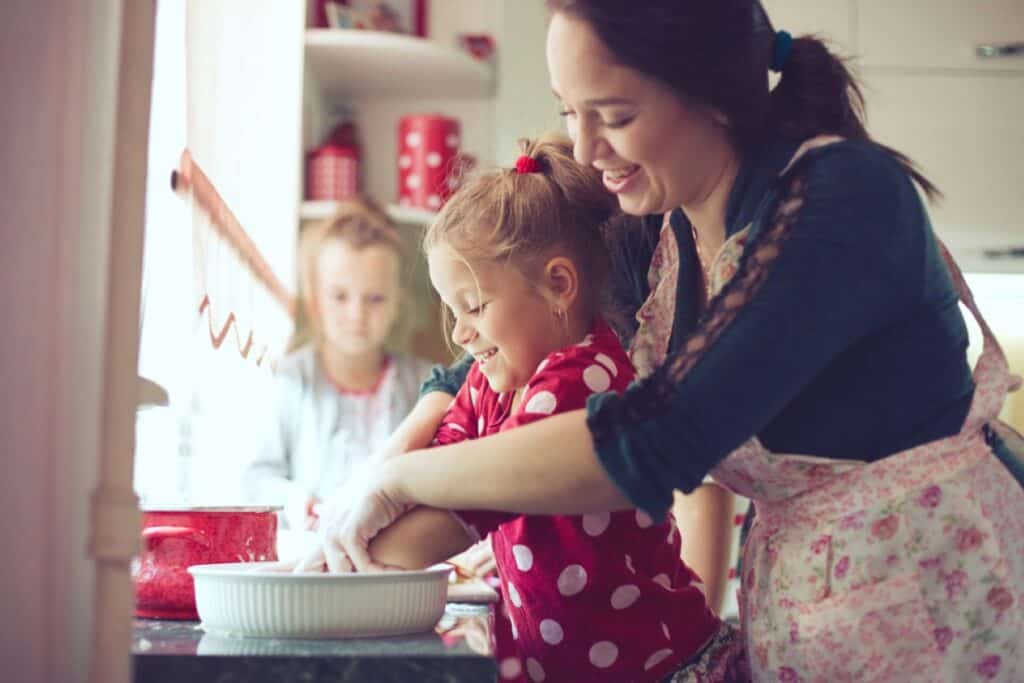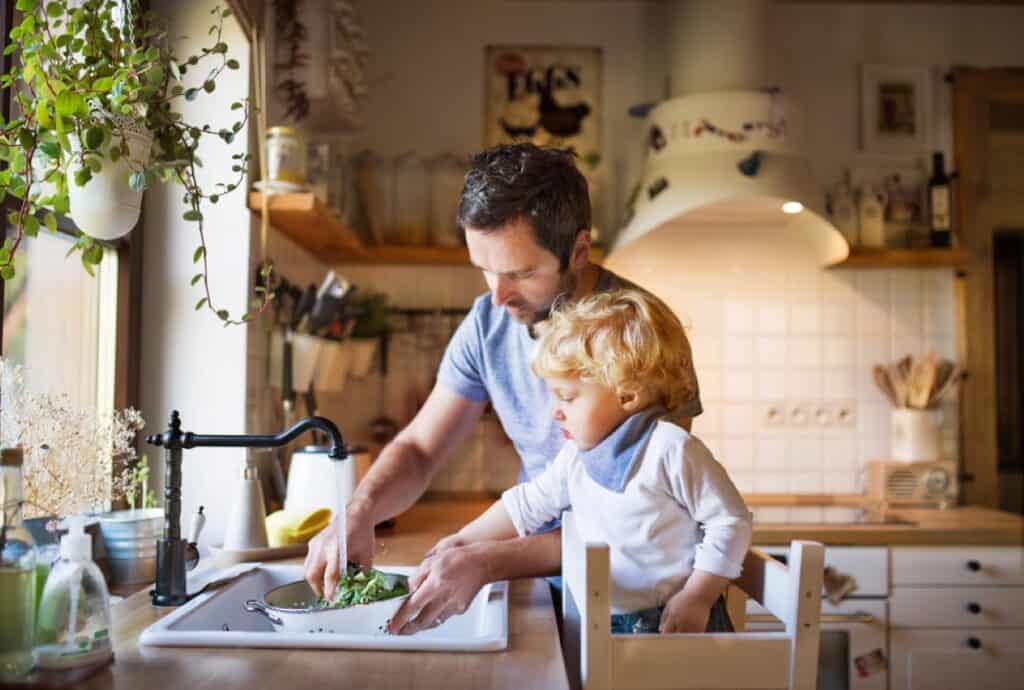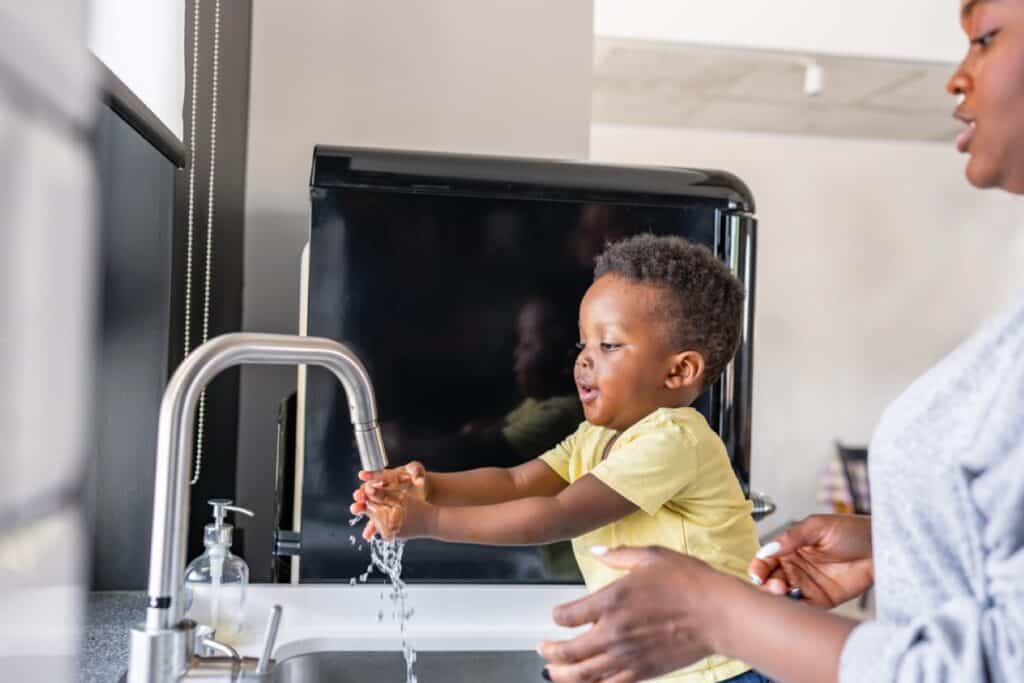Ask some parents to picture their kids cooking, and they may feel a stab of horror. Messy kitchens, undercooked entrees and dangerously sharp tools are just a few of the concerns parents have about their kids helping out in the kitchen. But would you believe that cooking with your kids doesn’t have to be a source of stress?

In reality, teaching your kids how to cook is an excellent way to foster healthy eating habits and future life skills — all while enjoying some quality family bonding time. And you may be surprised when you learn how early this process can start.
Even preschool-age kids can help out in the kitchen with small tasks that will build their self-confidence and teach them about food. No matter your kids’ ages, there are some core ingredients for success in the kitchen: creating a kid-friendly kitchen space, following basic safety rules and choosing age-appropriate recipes together.
Last but not least, remaining mindful of the cooking process will help you truly cultivate your little ones’ love for cooking. Before you know it, they might even be helping you create your next family meal plan — or at least making suggestions from the peanut gallery.
Kid-friendly essentials to use in the kitchen
All too often, grown-ups forget what it’s like to be small: it’s one of the reasons why we’re reluctant to let kids play outdoors on their own, for example. And when it comes to cooking, from out-of-reach ingredients to overly large utensils, kitchens just aren’t built for little ones. Luckily, there are some simple tweaks you can implement to create a safer, more inviting kitchen environment for your kids.
Tools for your miniature Master Chef
From kid-safe knives to smaller cutting boards, there are many different options out there that are designed to help kids get involved in the kitchen. A kid-sized apron will help them stay tidy, while oven mitts for older kids will help them grasp hot items safely.
Limiting your kids to child-safe tools doesn’t have to hold them back in the kitchen. For example, you can prepare a sausage and veggie sheet pan dinner together by delegating some of the chopping to them while you supervise.
Help kids reach what they need safely
Sure, your little ones might be willing to help you out by clambering all over the counters in search of the baking powder. An easier and safer option is a toddler tower, an adjustable stool designed to help toddlers reach what they need safely. Even a simple step stool may be enough to give your kids that extra boost.

Depending on how your kitchen is designed, you may want to set aside a reachable space for the utensils and ingredients that your kids use the most often. For example, are your lower shelves dedicated to big pots that only get used once a year? Consider moving them elsewhere to free up that space for your kids’ cooking supplies.
Safe practices for your kitchen

Cooking together means that you’re around to supervise, but even the most careful parents can occasionally get distracted. Teach your kids these kitchen rules to keep them out of danger in the kitchen, with appropriate tweaks for their age as needed:
- Basic hygiene. Your kids should tie their hair back and wash their hands as needed. Fresh produce should be rinsed, and raw meat should always be handled with caution.
- Handling hot surfaces and sharp objects with caution. Even if your kids are too young to use dangerous objects like the stove or knives, make sure they know what those objects are so that they do not approach them.
- Safe cooking techniques. As your kids get older, you can teach them how to cook and chop safely.
- Basic first-aid knowledge. Accidents happen, so make sure your kids understand what to do. For example, if they’re old enough to cook alone, teach them to always smother a grease fire, not pour water on it. Likewise, younger kids should know how to deal with small cuts or burns and where to find first aid supplies.
- Clear guidelines. Your kids should know what they can do on their own and when to ask for help or supervision. For example, maybe your kids are old enough to prep ingredients on their own but need your supervision to use the stove or the oven.
Choosing recipes to enjoy together
Today, saving money on groceries is already challenging enough. The last thing you want is for food to go to waste because of a recipe gone wrong. Carefully picking recipes can help you avoid kitchen disasters and wasted food.
Simple meals with only a few ingredients or don’t require heat are good choices for young chefs. You should also look for recipes that focus on stirring, pouring or assembly, which are a great match for kids.
Cucumber tomato bites require mixing but not heat, making them a dish that kids can help with. In fact, you may be surprised at how much your little ones enjoy carefully assembling the bites.
Here are some other factors to look for when evaluating recipes:
- Learning opportunities. Help your kids practice basic math skills like fractions, counting and measuring through cooking. Asking little ones to read recipes out loud is a great way to improve their reading comprehension, too.
- Customizable dishes. Do your kids love it when they get to make something of their very own? Personal pizzas, burritos or tacos will let them take the lead.
- Creative cooking. Spark kids’ interest by introducing themed cooking adventures like Meatball Monday or breakfast for dinner. Or show them how to add a twist to traditional recipes, such as by making this taco dip with cream cheese.
Cultivating a love for cooking
When you’ve had a tough day and just want to put dinner on the table at a reasonable hour, it’s tempting to shoo the kids away from the kitchen. Preparing every single meal together may not be realistic. But as you try out new recipes together, you might be surprised at how much you and your kids begin to love cooking as a family.
Cooking together isn’t about maximizing efficiency or doing it perfectly. Instead, it’s a way to help your kids develop skills they will later use to thrive as adults.
So don’t panic if things go wrong at first. Celebrating small successes and learning from mistakes will provide your little ones with the patience and encouragement they need to keep coming back. And someday, when your kids are grown-ups making all sorts of delicious dishes, you can reflect on how it all started in your very own kitchen.
Sara Nelson is the creator of Real Balanced, a food blog that showcases easy and balanced recipes. She lives in Wisconsin with her husband and two young children, who love to cook alongside her in the kitchen.